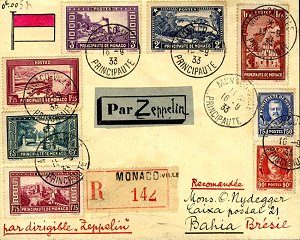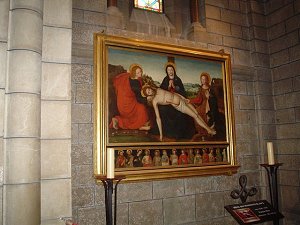Principality before the Second World War
 The principality, which was reduced in size and deprived of resources, was in an extremely difficult financial and economic situation. Raising taxes further was impossible. Back in the 1850s, the authorities decided to improve the matter by opening a casino, but the gambling house of the French businessman Duran was soon closed due to lack of transport connections and lack of competitiveness. The businessman Lefebvre, who bought the company, also failed to fix the matter.
The principality, which was reduced in size and deprived of resources, was in an extremely difficult financial and economic situation. Raising taxes further was impossible. Back in the 1850s, the authorities decided to improve the matter by opening a casino, but the gambling house of the French businessman Duran was soon closed due to lack of transport connections and lack of competitiveness. The businessman Lefebvre, who bought the company, also failed to fix the matter.
After several attempts to revive trade, Charles III and his mother Carolina decided to organize a company called the “Sea Bathing Society”. The concession for the creation of a gambling house was sold for 1.7 million francs to the banker Francois Blanc, who earlier headed the gambling house in Hamburg.
The term of his license was 50 years. Blanc was able to organize a casino and deploy operations, the volume of which soon exceeded the most optimistic expectations. Hotels, theater and casinos, built by the “Society of Sea Bathing”, from the very beginning began to attract many tourists to the Principality.
In 1865, Monaco signed a convention on the establishment of a customs union with France. At the same time, the prince reserved the right to conclude international treaties and agreements. The parties agreed on the construction of a railway line on Monaco territory. Since 1868, when the railway line between Nice and Ventimiglia came into operation, the number of tourists has increased even more. In 1870 the country was visited by 140 thousand people, and in 1907 – more than 1 million (at that time 52 hotels were operating in the principality).
Monaco’s economic progress has been accompanied by the expansion of urban construction. The Spelug quarter surrounding the casino was quickly built up with luxury hotels and prestigious buildings. In 1866, he received a new name by the name of the prince – Monte Carlo. In 1869, an opera opened in Monte Carlo, which, under the direction of the famous conductor Raul Gainsbourg, gained world fame.
During the reign of Charles III, stations were built in Monaco and Monte Carlo, a post office was organized, the first postage stamps of the principality were issued, and gold coins were minted. A separate bishopric was established in Monaco. In 1881, a civil code was enacted.
The population grew rapidly. In 1870, only 1,500 people lived in the principality; in 1888 this number increased to 10 thousand, and in 1907 – up to 16 thousand. The foreign policy activity of the principality also developed. In 1866–1905 Monaco concluded extradition treaties with Italy, Belgium, France, the Netherlands, Russia, Switzerland, Austria-Hungary, Great Britain, Denmark, as well as a convention on legal cooperation with Italy, Belgium and France.
Monument to Prince Albert I The Principality signed multilateral agreements: the Paris (1883) and Berne (1886) conventions and the Madrid Agreement (1891). It appointed ambassadors and diplomatic representatives to France, Spain, Italy, Belgium, as well as to the papal court.
Prince Albert I (1889–1922) became famous for scientific research in the field of oceanography, paleontology, anthropology and botany. He founded the Institute of Oceanography in Paris with the famous Oceanographic Museum in Monaco (opened in 1910), the International Peace Institute (1903) and the Exotic Garden, and contributed to the development of the Museum of Prehistoric Anthropology in Monaco and other research institutions.
In 1911, the prince approved the constitution of the principality of Monaco. In accordance with it, the monarch retained very broad powers, but shared the legislative power with the National Council, which was elected by universal suffrage. In October 1914, the constitution was suspended.
Albert I patronized the development of art and culture: magnificent performances were held at the Monaco Opera, and the famous seasons of Russian ballet were held in Monaco. Monaco was active in diplomatic activity.
According to the 1912 convention, French troops could be introduced into the territory of the principality only at the preliminary request of the prince. In 1914, Albert I tried unsuccessfully to persuade the German emperor to abandon the outbreak of hostilities in the First World War. His son Louis served in the French army, and during the First World War he rose to the rank of general.
Monaco officially maintained neutrality in the First World War, but France was afraid that the principality might fall under German influence, since Louis’s heir was not married, and the prince’s cousin, Duke Wilhelm von Urach was a subject of Germany. On July 17, 1918, Monaco was forced to sign an agreement with France, which entered into force on June 23, 1919.
The French Republic recognized and guaranteed the independence, sovereignty and territorial integrity of the Principality. In turn, the principality’s government was obligated to act “in accordance with the political, military, maritime and economic interests of France” and coordinate its foreign policy with it. Monaco or French citizens approved by the French government could become heirs or regents of Monaco. In the event that the princely dynasty ceases, Monaco was to form an autonomous state under the protectorate of France. The French army and navy gained the right to occupy Monaco, even without the consent of the prince.
A political crisis erupted in the country in 1918, when the National Council refused to recognize the legitimacy of a daughter born to the throne successor of Louis outside of marriage. The authorities issued an order on October 30, 1918, allowing the heir to adopt or adopt children in the absence of their own legal descendants.
Louis II (1922–1949) tried to maintain the independence of the principality in a difficult international situation and in the conditions of the economic crisis of the 1930s. During the Second World War, the troops of the belligerent powers entered the principality twice. The grandson of the prince during the war served in the French army.



